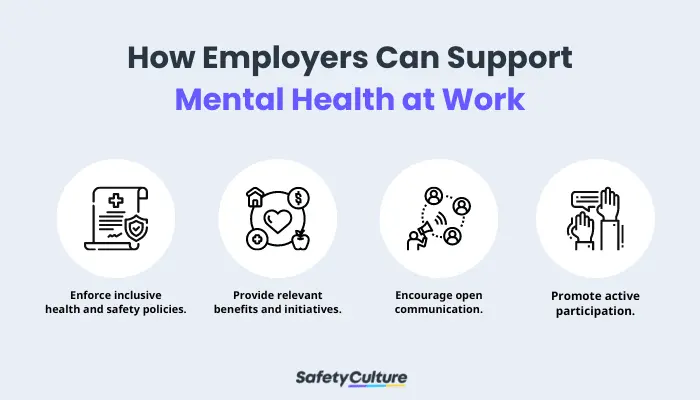What is Mental Health at Work?
Mental health at work pertains to the employees’ overall psychological, emotional, and social well-being in the workplace. Apart from physical health, employers and employees must also look after and prioritize workplace mental health as this leads to various business benefits, improved individual welfare, and sustainable ways to achieve business success.
Why is Mental Health Important at Work?
According to the US Department of Labor, almost 1 in 5 Americans experience some kind of mental health condition every year. In relation to this, one major factor in one’s overall health is work, whether with or without mental health conditions. This is where the role of employers comes in. They have the legal obligation to look out for the general well-being of their workers. Hence, it’s important to include mental safety at work on your workplace agenda.
In general, mental health at work is under the huge notion of psychological safety. When employees feel psychologically safe to act, speak up, and participate in activities at work, their mental health is less likely to be compromised and hence bring about a positive impact not just in the work they do but also on the people who surround them. These then contribute to an organization’s success in workplace safety implementation.
Risks
Mental health at work has various impacts both on the business and the employees. According to the World Health Organization (WHO), the following are the risks to mental health at work (which are also known as psychosocial hazards or risks):
For employers
- Poor company culture that fosters negative behavior
- Inadequate or unsafe working environment
- Inefficient job design processes
- Misaligned investment in career development
For employees
- Being under-skilled
- Insufficient support from co-workers and supervisors
- Unbearable workloads
- Workplace violence
To help your organization mitigate and manage workplace mental health risks, you must consider conducting health and safety risk assessments. Using a checklist or template that suits your organization is also advisable to ensure you have a handy tool to use whenever you need it.
Create Your Own Workplace Mental Health Risk Assessment Form
Eliminate manual tasks and streamline your operations.
Get started for FREESigns
Some signs of an employee struggling with mental health at work include:
- Lack of engagement
- Poor job performance
- Low productivity
- Ineffective communication
- Poor decision-making
How to Support Mental Health at Work

How Employers Can Support Mental Health at Work
While fostering a mentally healthy workplace requires effort from everyone in the organization, the employer must take the initiative to create programs for effective implementation. Here are some examples and tips on how to manage mental health at work.
Enforce inclusive health and safety policies.
An organization’s policies shouldn’t be limited to favoring the employees’ physical well-being. Instead, their mental health should also be prioritized. Recognizing that every employee may have unique needs and that an inclusive set of policies is a must helps create and implement better wellness programs for the business.
Provide relevant benefits and initiatives.
Making employees feel and realize that their employers value not just their contributions to the organization but also their individual health and safety can lead to various advantages for the business. These include increased productivity and enhanced employee morale, among others.
Employers, with the help of the Human Resources (HR) department and other relevant teams, can start with the following benefits and initiatives:
- Employee Assistance Program (EAP)
- Wellness activities and amenities (relaxation spaces, monthly pampering)
- Mental health assessment tools
- Specific benefits that cover mental health, such as mental health consultations and check-ups, mental health leaves, and the like
- Diversity and inclusion in the workplace
Encourage open communication.
Talking about mental health at work shouldn’t be frowned upon. Instead, it must be part of a manager’s coaching session, a company’s inclusive culture, and the employees’ way of being open about their struggles that affect their job performance, for instance.
Promote active participation.
Active participation from the employees is also encouraged so that these tips for mental health at work are best implemented. As you deem fit, you can consider incentivizing employee participation to encourage them to be more involved in such activities.
Apart from that, help them become more open to the possible benefits they can reap once they commit to your organization’s efforts by providing relevant resources. These efforts can lead to a sustainable way of continuously improving your culture of health and safety.




